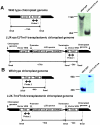Autoluminescent plants
- PMID: 21103397
- PMCID: PMC2980496
- DOI: 10.1371/journal.pone.0015461
Autoluminescent plants
Abstract
Prospects of obtaining plants glowing in the dark have captivated the imagination of scientists and layman alike. While light emission has been developed into a useful marker of gene expression, bioluminescence in plants remained dependent on externally supplied substrate. Evolutionary conservation of the prokaryotic gene expression machinery enabled expression of the six genes of the lux operon in chloroplasts yielding plants that are capable of autonomous light emission. This work demonstrates that complex metabolic pathways of prokaryotes can be reconstructed and function in plant chloroplasts and that transplastomic plants can emit light that is visible by naked eye.
Conflict of interest statement
Figures





References
-
- Wilson T, Hastings JW. Bioluminescence. Annu Rev Cell Dev Biol. 1998;14:197–230. - PubMed
-
- Meighen EA. Bacterial bioluminescence: organization, regulation, and application of the lux genes. FASEB J. 1993;7:1016–1022. - PubMed
-
- Baumann P, Baumann L, Woolkalis M, Bang S. Evolutionary relationships in Vibrio and Photobacterium. A basis for a natural classification. Ann Rev Microbiol. 1983;37:369–398. - PubMed
-
- Lin JW, Chao YF, Weng SF. Characteristic analysis of the luxG gene encoding the probable flavin reductase that resides in the lux operon of Photobacterium leiognathi. BBRC. 1998;246:446–452. - PubMed
Publication types
MeSH terms
Substances
LinkOut - more resources
Full Text Sources
Other Literature Sources

